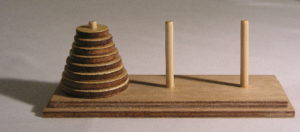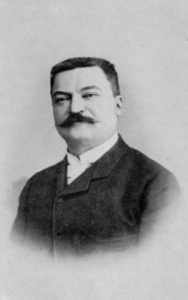Tasks
|
Can you move the discs from one hole to another? You can only move one disc at a time. Never put a smaller disc on top of a bigger one. |
|
How many moves did you take to move four discs? Was that the fewest number of moves possible? |
|
How many moves would it take to move five discs? How many moves would it take in general? |
|
Maths
To solve this classic puzzle, never place two discs of the same colour together, with this hint the puzzle will solve itself automatically. Four discs can be solved in 15 moves.
If we had five discs, first we would have to move four discs to a new hole (15 moves), then move the fifth disc (1 move), then move the four discs on top of the fifth disc (another 15 moves). That makes a total of 31 moves.
In general, n discs can be solved in 2n-1 moves.
|
History
Our puzzle is an inverted version of a puzzle called Tower of Hanoi, where discs are stacked onto pegs. The puzzle was invented in 1883 by French mathematician Édouard Lucas and has been a popular puzzle ever since. In the puzzle there is often claimed to be a temple in Hanoi, Vietnam, where the monks move 64 golden discs from one peg to another. If the monks were to move one disc per second, it would take them 585 billion years to finish.

|
People
 Édouard Lucas 1842 – 1891 Édouard Lucas 1842 – 1891
Édouard Lucas was a mathematician who loved games and puzzles and invented the classic Tower of Hanoi puzzle. He is almost famous for studying Fibonacci numbers, and similar sequences now called Lucas numbers. He was able to show the number 2127-1 was prime, which took him 19 years to do by hand. At the time, it was the largest prime number ever found. |
|
Applications
This puzzle is an example a problem that you want to solve as efficiently as possible, but it gets more complex with more discs. Other real-life optimisation problems include routing telephone calls through busy networks while minimising connection time, constructing complex machinery while keeping costs and build-time low, and finding the most efficient set-down and pick-up routes for delivery vehicle.
|
Maths at Home
|